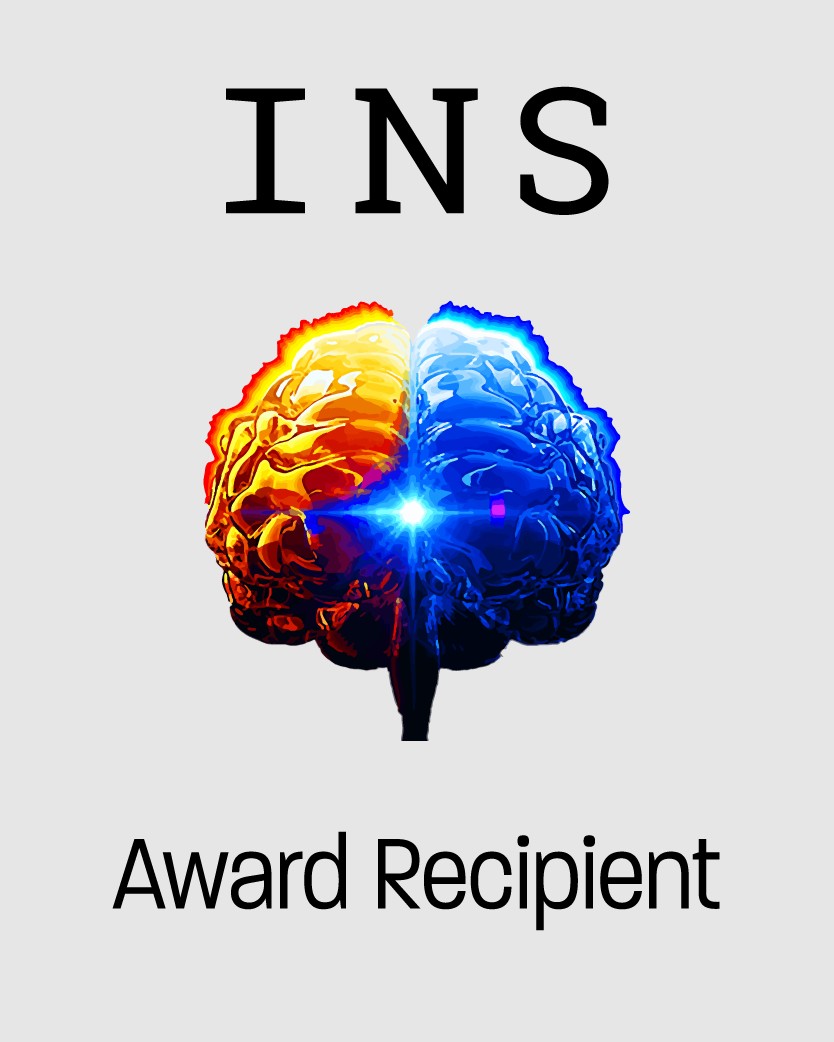INS Post-Doc Fellow Research Award Recipients
The prize is awarded at the Society’s Annual and Mid-Year Meetings for the best research presented by a postdoctoral fellow. The recipient is selected at the discretion of each Meeting Program Chair. No formal application is necessary (all submissions by postdoctoral fellows are considered).
* Award recipients receive an honorarium of $500 USD.

Post-Doc Fellow Research Award Recipient
INS 50th Annual Meeting
New Orleans, Virtual Meeting – February 2-4, 2022
Frontotemporal dementia (FTD) is a group of young-onset neurodegenerative disorders primarily affecting frontal and/or temporal lobes. Two common clinical variants include a behavioural variant (bvFTD), presenting with primary behavioural/personality changes arising from early prefrontal atrophy, and a semantic variant (semantic dementia or SD), displaying semantic dysfunction and conceptual knowledge loss due to early anterior temporal lobe degeneration. Although treated as independent diagnostic entities, accumulating evidence indicates overlapping behavioural, cognitive, and neuropsychiatric profiles between both syndromes. Why such overlap occurs remains unclear, however, needs resolution for improved clinical diagnosis and characterisation of both syndromes. Here, we used data-driven methods to extract neurocomputational ‘dimensions’ of behavioural, cognitive, and neuropsychiatric heterogeneity in FTD.

Post-Doc Fellow Research Award Recipient
INS 2021 Mid-Year Meeting
Melbourne, Australia – June 30 – July 3, 2021
Telehealth-delivered neurodevelopmental Assessments in children and adolescents (Tele-Assess): preliminary neuropsychological assessment results (MCRI, AUS)

Post-Doc Fellow Research Award Recipient
INS 49th Annual Meeting
San Diego, Virtual Meeting – February 2-5, 2021
Early-life SES continues to impact cognitive performance later on life independently of the educational level achieved and late-life SES. The higher percent mediation for education mediated path suggests that education achievement might improve later life cognition in the face of lower early-life SES. Finally, middle-aged adults might have benefited from small, but essential, socioeconomic changes faced by Brazil during their birth and schooling decades, through better social conditions and education access, reducing the early-life effect. Our results highlight the importance of early-life and educational politics to improve cognitive aging quality in a low-/middle-income country.
Nelson Butters Award
This award was established to honor the contributions of Dr. Nelson Butters and to recognize the impact he has had in the area of training. The prize is awarded at the Society’s Annual and Mid-Year Meetings for the best research presented by a postdoctoral fellow.

Nelson Butters Award Recipient
INS 48th Annual Meeting
Denver, Colorado, USA – February 5-8, 2020
Post-mTBI daytime sleepiness, as well as depressive and somatic symptoms, positively responded to BLT. Reduced daytime sleepiness and depressive symptoms likely have important implications for neurophysiological healing, mental health status, daytime functioning and overall quality of life. Further research is necessary to explain the directional relationships (i.e. improved symptoms lead to lower daytime sleepiness).

Nelson Butters Award Recipient
INS 2019 Mid-Year Meeting
Rio de Janeiro, Brazil – July 10-12, 2019
There is a recent growing interest in the extent to which personality is related to cognitive performance and brain functioning. We and others found robust evidence that personality affect cognitive performance in several domains across the adult lifespan, however there is little evidence how personality is associated to brain functioning, particularly brain connectivity. The aim of the current research was to investigate the association between personality traits and brain-network connectivity.

Nelson Butters Award Recipient
INS 47th Annual Meeting
New York City, New York, USA – February 20-23, 2019
Mild cognitive impairment (MCI) in non-clinic samples often have high prevalence and unclear predictive validity for dementia risk. We used longitudinal data from a communitybased cohort to evaluate whether MCI stability over two years reliably identified people who would develop dementia.

Nelson Butters Award Recipient
INS 2018 Mid-Year Meeting
Prague, Czech Republic – July 18-20, 2018
Ample empirical evidence exists for executive deficits in schoolchildren with developmental language disorder (DLD). Little is known though about EF in preschoolers with DLD. Since early childhood is the primary period for both language and EF to develop, the early development of language and EF plausibly interact in an empowering or inhibitive way (see Vissers et al., 2015). Therefore, to come to insight into the aetiology of DLD, research on early EF and language development is necessary.

Nelson Butters Award Recipient
INS 46th Annual Meeting
Washington, D.C, USA – February 14-17, 2018
Impaired fear learning and memory are core features of post traumatic stress disorder (PTSD) that are subserved by the hippocampus. Some, but not all, studies report smaller hippocampal volumes in PTSD patients compared to controls, and this inconsistency may reflect underlying differences in hippocampal subregions across cohorts. We tested this in an international sample of patients and controls in the PGC-ENIGMA PTSD Working Group.

Nelson Butters Award Recipient
INS 2017 Mid-Year Meeting
Cape Town, South Africa – July 5-8, 2017
Seven participants (32%) were carriers of the APOE4, while 15 (68%) were not. Bootstrapped between-group tests indicated that APOE4 carriers evidenced accelerated decline in processing speed (p=.016) and global cognition (p=.007) compared with non-carriers. Furthermore, trends were found for working memory (p=.065) and verbal fluency (p=.062). A trend towards increased inflammatory response was observed in carriers of APOE4 (p=.054).

Nelson Butters Award Recipient
INS 45th Annual Meeting
New Orleans, Louisiana, USA – February 1-4, 2017
In prior studies (Nair et al., 2013; Nair et al., 2015), we demonstrated that children with autism showed mostly reduced connectivity especially for prefrontal-thalamic networks, accompanied by overconnectivity within temporal-thalamic networks. Given the importance of early identification of biomarkers and endophenotypes of autism, it is crucial to understand how early in the developmental process these differences in thalamocortical networks emerge.

Nelson Butters Award Recipient
INS 2016 Mid-Year Meeting
London, England, UK – July 6-8, 2016
Best Submission By A Postdoctoral Fellow

Nelson Butters Award Recipient
INS 44th Annual Meeting
Boston, Massachusetts, USA – February 3-6, 2016
Previous research has demonstrated heterogeneity in neuropsychological performance and biomarker profiles within MCI samples. We previously identified four empirically-derived MCI subtypes within the Alzheimer’s Disease Neuroimaging Initiative (ADNI) MCI cohort: amnestic MCI, dysnomic MCI, dysexecutive/mixed MCI, and a large cluster-derived normal group (34%) that was characterized by intact neuropsychological performance (despite their MCI diagnosis). The current study investigated cortical thickness profiles in these four cognitive subtypes.

Nelson Butters Award Recipient
INS 2015 Mid-Year Meeting
Sydney, Australia – July 1-4, 2015

Nelson Butters Award Recipient
INS 43rd Annual Meeting
Denver, Colorado, USA – February 4-7, 2015
Traumatic brain injury (TBI) is believed to result in alterations in functional connectivity in intrinsically connected networks. One such network is the default mode network (DMN), which displays increased activation in absence of an externally-imposed task and decreased activation during cognitively demanding tasks. Studying factors associated with post-TBI functional connectivity in the DMN may help further elucidate the role of this network, as well as the effects of TBI on functional connectivity in general.

Nelson Butters Award Recipient
INS 2014 Mid-Year Meeting
Jerusalem, Israel – July 9-11, 2014
The goal of this presentation is to provide a critical overview of the current approaches used to examine functional brain connectivity in neurologically impaired samples. There is now a growing literature using functional imaging methods to examine brain network changes and it is a goal in this presentation to offer a critique of the current methods used to examine brain pathology and aging including possible pitfalls and advantages of each approach.

Nelson Butters Award Recipient
INS 42nd Annual Meeting
Seattle, Washington, USA – February 12-15, 2014
Presented for the Best Submission by a Postdoctoral Fellow
Transcranial Direct Current Stimulation Changes Frontoparietal Control Network Connectivity Associated with Working Memory Performance in High-Functioning Autism

Nelson Butters Award Recipient
INS 2013 Mid-Year Meeting
Amsterdam, the Netherlands – July 10-13, 2013
Presented for the Best Submission by a Postdoctoral Fellow
Cognitive Abilities of Children Prenatally Exposed to Opiates and Polysubstances: A Longitudinal Study

Nelson Butters Award Recipient
INS 41st Annual Meeting
Waikoloa, Hawaii, USA – February 6-9, 2013

Nelson Butters Award Recipient
INS 2012 Mid-Year Meeting
Oslo, Norway – June 27-30, 2012

Nelson Butters Award Recipient
INS 40th Annual Meeting
Montreal, Quebec, Canada – February 15-18, 2012

Nelson Butters Award Recipient
INS 2011 Mid-Year Meeting
Auckland, New Zealand – July 6-9, 2011

Nelson Butters Award Recipient
INS 39th Annual Meeting
Boston, Massachusetts, USA – February 2-5, 2011

Nelson Butters Award Recipient
INS 2010 Mid-Year Meeting
Krakow, Poland – June 30-3, 2010

Nelson Butters Award Recipient
INS 38th Annual Meeting
Acapulco, Mexico – February 3-6, 2010

Nelson Butters Award Recipient
INS 2009 Mid-Year Meeting
Helsinki, Finland and Tallinn, Estonia – July 29-1, 2009

Nelson Butters Award Recipient
INS 37th Annual Meeting
Atlanta, Georgia, USA – February 11-14, 2009

Nelson Butters Award Recipient
INS 2008 Mid-Year Meeting
Buenos Aires, Argentina – July 2-5, 2008

Nelson Butters Award Recipient
INS 2008 Mid-Year Meeting
Buenos Aires, Argentina – July 2-5, 2008

Nelson Butters Award Recipient
INS 2007 Mid-Year Meeting
Bilbao, Spain – July 4-7, 2007

Nelson Butters Award Recipient
INS 2006 Mid-Year Meeting
Zurich, Switzerland – July 26-29, 2006

Nelson Butters Award Recipient
INS 2003 Mid-Year Meeting
Berlin, Germany – July 16-20, 2003

Nelson Butters Award Recipient
INS 31st Annual Meeting
Honolulu, Hawaii, USA – February 5-8, 2003

Nelson Butters Award Recipient
INS 30th Annual Meeting
Toronto, Canada – February 13-16, 2002
